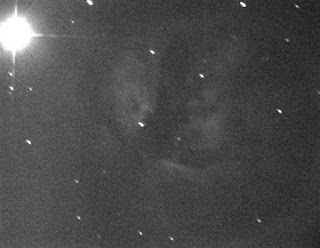The sun is finally clearing the trees again at my observatory site! Here are two images of ARs 2488 (with the big "blobby" filament) and 2489 (with a small prominence visible). The Newton's Rings are a problem--I took these images with a Barlow (PST-DS scope) and ASI 120MM imager. Neverthless, it's good to be back imaging again!
The trials, tribulations and small triumphs of a Charlotte, NC astronomer imaging under Bortle 8/9 skies.
Thursday, January 28, 2016
The Sun on 1.28.2016
The sun is finally clearing the trees again at my observatory site! Here are two images of ARs 2488 (with the big "blobby" filament) and 2489 (with a small prominence visible). The Newton's Rings are a problem--I took these images with a Barlow (PST-DS scope) and ASI 120MM imager. Neverthless, it's good to be back imaging again!
The Flame Nebula (NGC 2024) 1.27.16
I took advantage of some breaks in the clouds to do some imaging with the VRC and my DSm camera last night. The sky was a little hazy and bars of cloud moved over the imaged areas from time to time, but, as there was no moon, conditions were actually better than they were the last time I imaged a couple of days ago.
These are images of the Flame Nebula (NGC 2024). The bright star at the top of the image is Alnitak, which sends ultraviolet light into the Flame. This knocks electrons of the masses of hydrogen gas; the glow of the nebula is mostly from the recombining electrons and hydrogen. The nebula is part of the huge Orion Molecular Cloud--a star forming region. Note also the lanes of dark gas and dust in these images. The integrations were all around 20-30 seconds long with dark frame processing enabled.
Thursday, January 21, 2016
First Light 152mm VRC Mallincam Ritchey-Chretien Astrograph/ZEQ25 -- 12.20.2016
For the first time in months, we had clear skies and passable temperatures last night (20 degrees F!). I was finally able to take out my "Christmas Prezzie" of a 152mm Mallincam VRC and iOptron ZEQ25 mount. The pix below were captured with a Mallincam DSm, Orion focal reducer and a skyglow filter. Imaging was complicated by the fact that the gibbous moon was in the same area of the sky I was imaging (the Orion Nebula region). While the moom washed out such faint objects as the Horsehead Nebula and the Flame Nebula, the Great Nebula itself was bright and prominent. These two images were captured with 5- and 10-second integrations with no dark frame processing. I adjusted the histogram for each in Photoshop.
The long exposure image really pulled out nebula detail; the VRC is a really high-contrast scope! The FOV enabled me to capture the main nebula and DeMairan's nebula, too (at approx. 6 o'clock position). All in-all, this is a great, compact, and inexpensive combination that enables you to get really great astro images!

The long exposure image really pulled out nebula detail; the VRC is a really high-contrast scope! The FOV enabled me to capture the main nebula and DeMairan's nebula, too (at approx. 6 o'clock position). All in-all, this is a great, compact, and inexpensive combination that enables you to get really great astro images!

Subscribe to:
Comments (Atom)
NGC 1333--20H with the Seestar S50 Bortle 8/9
NGC 1333. 20 hours total integration time under Bortle 8/9 skies. Processed in Siril with Veralux Hypermetric Stretch and cosmic clarity. Fi...

-
I had a couple of emails asking how to defork an ETX telescope. The ETX 90 and ETX 125 were optically superb scopes, but the mounts left a...
-
The ZEQ25 doing its stuff on a cold night--imaging the Orion Nebula with an 8 inch f/4 astrograph. Note the lovely Christmas rug :) As ...
-
One of the great things about being a part of an online community of people with similar interests is that you learn a lot from people who a...








